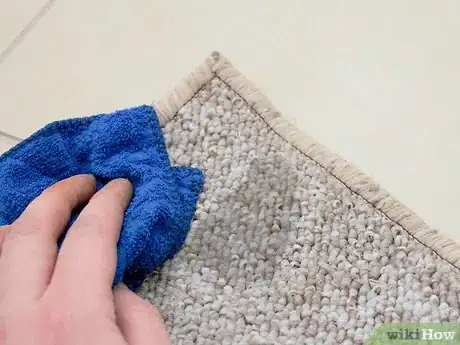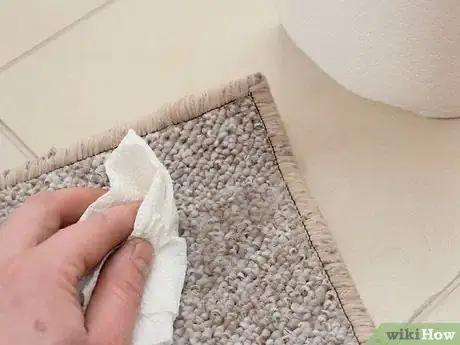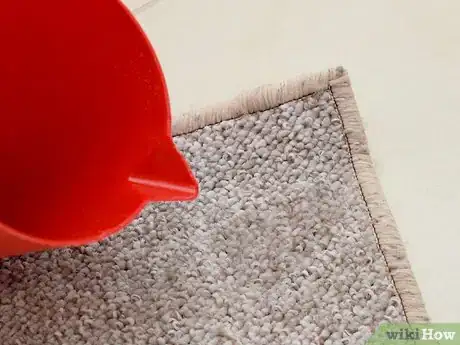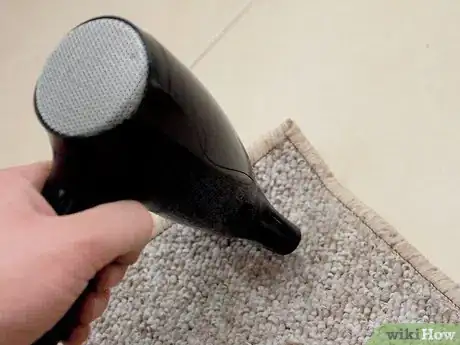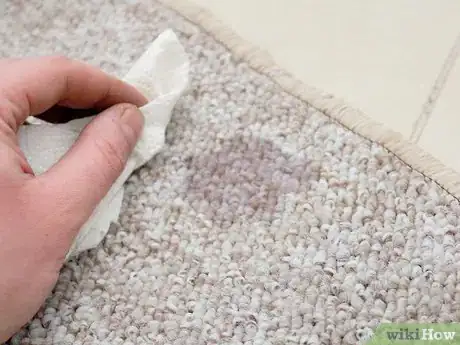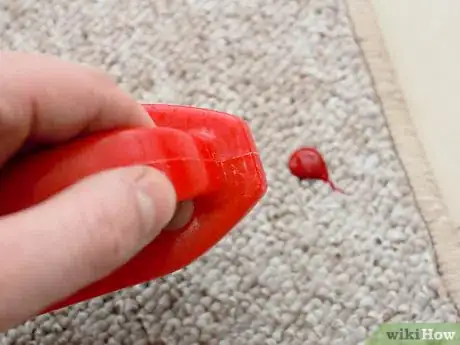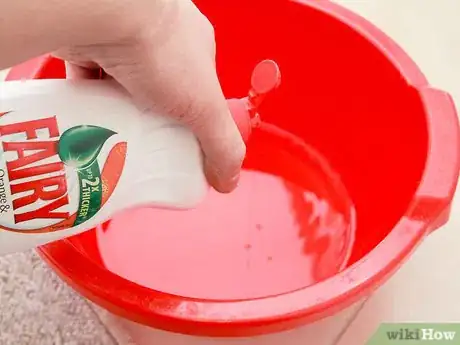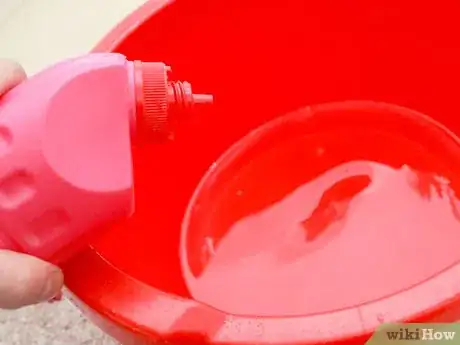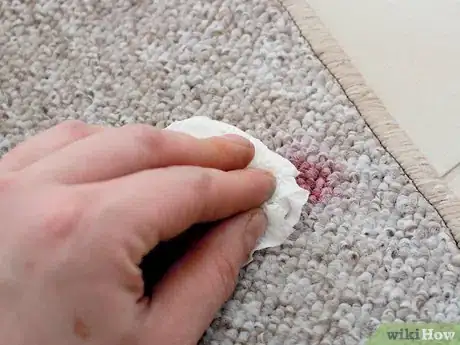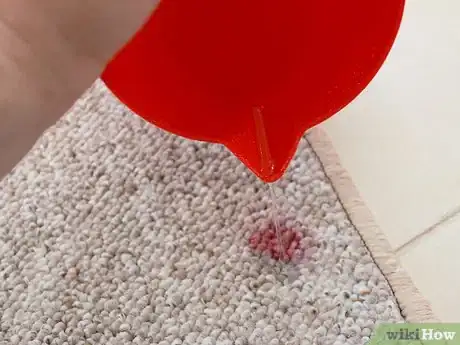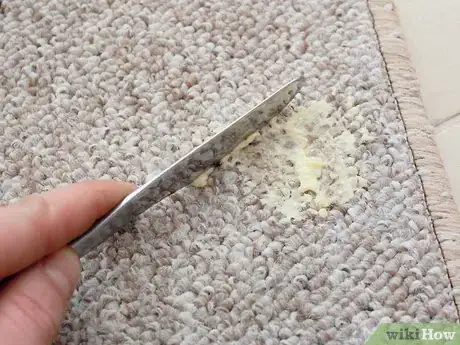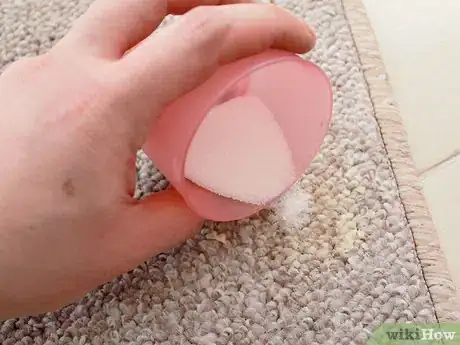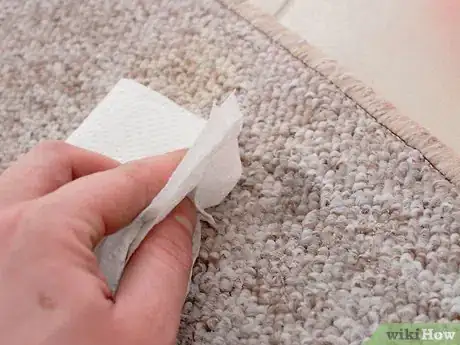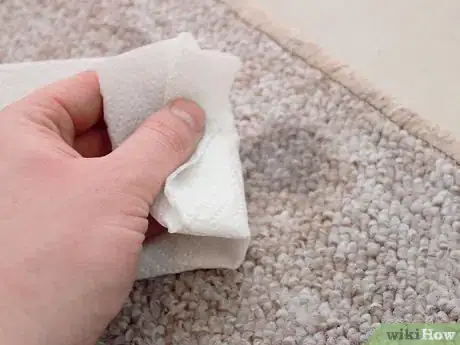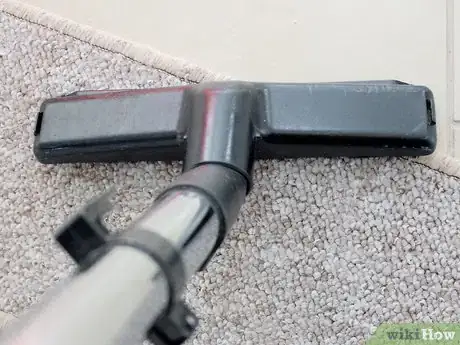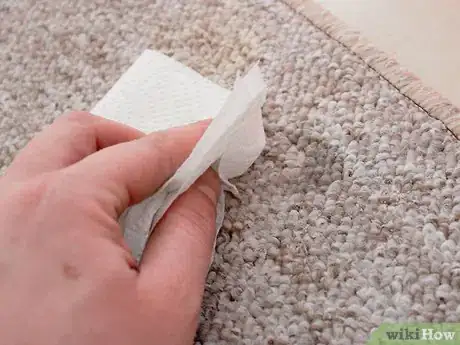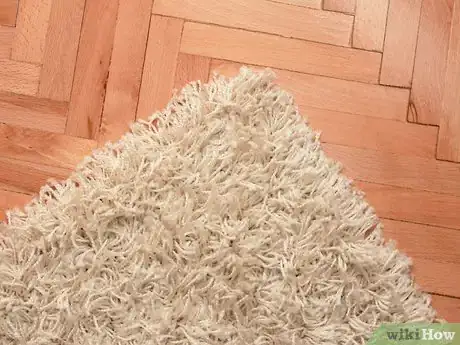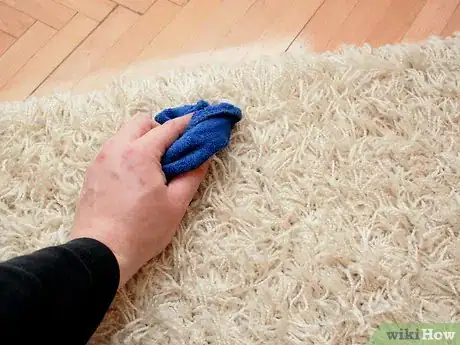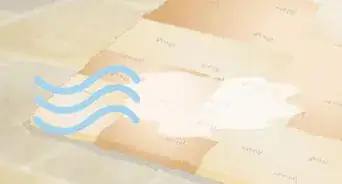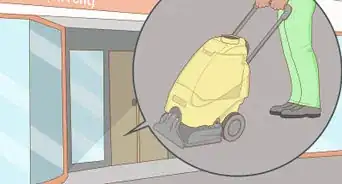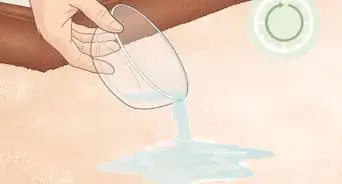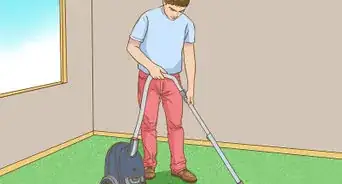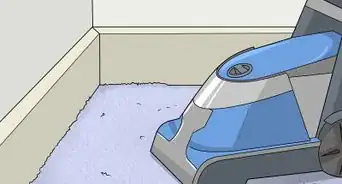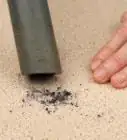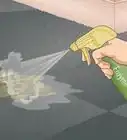This article was co-authored by Haim Shemesh. Haim Shemesh is a Carpet and Rug Cleaning Specialist and the Owner of Sunlight Fine Rug Care & Restoration, a business based in New York City. Haim specializes in Oriental, Persian, handmade, and antique rug cleaning and repair. He also conducts rug restoration along with fire damage care. He has over 17 years of experience in the carpet cleaning industry. Sunlight Fine Rug Care & Restoration has been awarded Angie's List Super Service Award in 2017 and 2018. Their clients include Staples, Ace Hotel, Momofuku, Banana Republic, and more.
There are 7 references cited in this article, which can be found at the bottom of the page.
This article has been viewed 260,736 times.
Nothing can spoil a good carpet like a stain. While the result is almost always unsightly, there are many possible types of stains you may have to deal with. Whether there's already a stain you need to fix or you simply wish to be prepared for a future scenario, there are plenty of solutions available to make your carpet stains a thing of the past.
Steps
Removing Water-Soluble Stains
-
1Blot the stain with a damp cloth. Water-soluble stains are potentially the easiest stains to fix, as they're often vulnerable to the effects of water. These include food dyes, soda, milk and most alcoholic beverages, among many other things. [1] First, you'll want to dab a washcloth or paper towel with some warm water. From there, place the towel firmly atop the stain. The warm water will help soak up part of the stain.
- This is best done as soon as possible. It'll be harder to soak up the stain once it dries.
-
2Add 1/4 teaspoon of non-bleach detergent (or white vinegar) to 32 ounces of water. Stir the two until you've made a consistent solution. With that, you'll have a homemade compound that's perfectly suited to weeding out stains of this sort. [2]Advertisement
-
3Apply solution to stain. With a new dishcloth, dip the cloth in your homemade solution and place the cloth on the stained area. From there, you should let it rest or gently press against the cloth to make sure it has as much surface contact as it needs.
- Using the convex side of a spoon to smooth and apply pressure is a good trick to use in this case. It will give smooth pressure without necessarily dispersing the stain any more than necessary.
-
4Blot again with paper towel. With the cleaning solution now in place, replace the cloth with another sheet of paper towel to further blot the stain. The solution should work to pick up the stain relatively well, so the blotting should be relatively effective the second time around.
-
5Rinse with warm water. Water-soluble stains are best dealt with by using more warm water. Add some water to the affected area for good measure.
-
6Repeat as needed. Depending on the size and severity of the stain in question, you may need to repeat these steps again. Although once or twice should do the trick for the majority of stains, repeat the cycle until the stain has been removed.
-
7Dry the carpet. Carpets left wet for more than 24 hours run the risk of growing bacteria, so it's a good idea to make sure your carpet is dry at the end of it.[3] Take a hair dryer or a bath towel and dry the area to your satisfaction. With that, your stain should be removed at last!
Removing Coffee and Wine Stains
-
1Blot stain with a paper towel. Coffee and wine are two of the most troubling domestic stains out there; the beverages are very common, and the stains they leave are insightful and horrid. as such, it's important to attend to them as soon as possible. Take an absorbent paper towel and blot the stain without delay. Try to refrain from rubbing or applying significant pressure to the stain at this stage-- you'll end up spreading the stain further if you do!
- A dish towel or light bathing towel will also suffice, although paper towel's preferable for its absorbent qualities.
-
2Mix one tablespoon of ammonia with one cup of water. Mixing water and ammonia together will make a potent solution to ward off wine stains. Stir them together in a cup and get them ready for use on your stain. [4]
- Use a mild detergent and water instead when treating wool-based carpets, as ammonia is known to have a destructive effect on them.
- Alternatively, you can use lemon juice and dish detergent. This combination is seen to be better used for coffee stains as opposed to wine stains.
-
3Apply lightly to a sponge. Get a kitchen sponge and dab it lightly in your ammonia solution. You'll want the sponge to be damp, but not soaked; you don't want to get more of the solution on the carpet than is necessary.
-
4Rub the sponge upon the stain. In curt, circular motions, apply the damp sponge to the stain and rub the affected area. Begin at the outside of the stain, and work your way gradually inwards; doing it as such will minimize the risk of spreading the stain.
-
5Remove excess moisture with another paper towel. Take a paper towel and blot the affected area. With the ammonia solution now in place, the stain in question should start to come undone. Blotting the area and adding some pressure with the convex side of a spoon will give the stain an opportunity to be lifted from the carpet.
-
6Repeat as needed. Depending on the size and severity of the stain, you may need to repeat these steps a few times before getting best results. Keep the ammonia solution on hand just in case; that way, you'll be able to continue using it.
Removing Blood and Urine Stains
-
1Scrape surface with steel brush if dry. Bodily fluids can make for very unique stains. Whereas blood carries a distinctive brown stain, urine adds insult to injury with a punishing odour. While blotting is the most effective option to treat new stains, if the stain has dried, you can scrape some of the surface material off with a steel brush. While this won't solve the core stain, it will at least make it easier to get at it with subsequent steps. [5]
- If you've got the stain while it's still wet, blot with me a paper towel or dishcloth damp with warm water.
-
2Apply a mix of dish soap and water to your stain. Adding a teaspoon of dish soap to a cup of water can make a powerful counter-agent against bodily fluid stains. Stir it together in a bowl or cup and dab the stain gently with a washcloth.
-
3Blot the stain again. Once you have the solution on the stain for five minutes, place another paper towel on the stain and let it blot up the stain. Repeat the process again if the stain requires it.
-
4Mix a half cup warm water with one tablespoon ammonia. Many bodily fluid stains will require more than dish soap to deal with entirely. If that's the case with your stain, take a half cup of water and add a tablespoon of ammonia. Stir it together and get it ready for use on your stain.
- White vinegar is a suitable replacement for ammonia if you're working to get urine out.
-
5Apply solution to stain. Once you have the ammonia solution ready, apply it to the stain lightly with a sponge. Begin rubbing in small, circular motions from the outside, moving in gradually. Take your time with it; you want to make sure the solution has a chance to inflict maximum damage on the stain.
-
6Blot again. Give the stain yet another sheet of paper towel to blot up the stain after giving the ammonia five minutes to soak in. If the ammonia solution has worked, the blood or urine should be much easier to remove. Feel free to use the convex side of a spoon to rub around if you feel the blot isn't going as well as expected.
-
7Rinse and dry. Adding some warm water after the fact is a good way to give your carpet an extra bit of cleaning. Make sure to dry it afterwards; a wet carpet runs the risk of growing mildew if left unattended after a day.
Removing Fat and Oil-based Stains
-
1Scrape off excess grease with a blunt knife. Fat and oil-based stains can be very messy, but they're deceptively easy to put to rest if you know how. First off, you'll want to get as much of the excess material gone as possible before moving in to clean the stain. This can be done by scraping a knife along the surface of the carpet; this will pick up some of the material, especially if the mess is very concentrated.
- It is recommended you get a blunt-edged knife (like a butter knife) for this, as sharp knives may risk cutting into the carpet itself.
-
2Sprinkle some baking soda and let it sit for five minutes. Baking soda is very well-known for its ability to provoke chemical reactions. Placing some baking soda on the affected area will loosen the fat or oiled-based stain's grip on your carpet, making it far easier to deal with. [6]
- Cornstarch is a functional alternative to baking soda in this case.
-
3Place a clothes iron atop a towel over the stained carpet. Adding some controlled heat will make the unwanted fats or oils to be much less resistant to removal.[7] Put your clothes iron on the low or medium setting. After it heats up, apply for a minute or so and then remove it.
- Remember to put the towel in between the clothes iron surface and the carpet. Direct application may cause damage to your floor.
-
4Sponge stain with dry-cleaning solvent. Take a dish towel and dab it with a powdered detergent or baking soda. Gently rub it upon the fat stain. You should notice the grease becoming thinner within a few seconds of doing this.
-
5Blot with a warm, damp paper towel. Blotting will give the liquid part of the fats or oils to seep up, leaving dry debris that is more appropriately dispatched with a vacuum.
-
6Give the area a vacuum. Vacuuming the stain will help to suck up any excess debris, now that the chemicals you've treated the stain with have been given ample time to unstick the fats. The solid matter in the stain should prove very easy to suck up. Don't spend more than a few seconds vacuuming over it; if the debris hasn't been sucked up by then, it may need more unsticking before it's truly ready.
-
7Repeat as needed. If it's not completed to your satisfaction the first time, it's a good idea to give it another shot. It's quite possible that some of it wasn't gotten the first time around.
Removing Industrial Fluid Stains
-
1Blot with a paper towel. Industrial fluid stains (like inks or some household chemicals) can be a major threat to the look of your carpet. Fortunately, like most other types of stains, they can be lessened considerably if you promptly place a paper towel over the affected area to blot up the fluid.
-
2Moisten stain with rubbing alcohol or a non-oil-based hairspray. Once you've gotten as much of the initial stain blotted as you can, apply a dab of rubbing alcohol or a non-oily hairspray to the affected area. The chemicals in these compounds will loosen the ink or fluid's hold on the carpet, making it much easier to extract the remaining stain.
-
3Vacuum the stain. With the stain lifted, running a vacuum over the stained area will pick up particles and do away with anything that's been sufficiently affected by the chemicals you've applied.
-
4Blot again with a light detergent. Add some light detergent onto the remaining stain and let sit for a minute. Following that, place a washcloth atop the area and let it soak up the stain. If you aren't seeing much progress with the blotting this time around, try adding some more rubbing alcohol and resetting the washcloth.
-
5Repeat as needed. Industrial fluid stains are varied in their severity and intensity; as such, it may take a few times before the issue is handled to your own satisfaction. Continue alternating between blotting and adding solution until the stain has been fixed.
Maintaining Carpets and Preventing Stains
-
1Get your carpet cleaned every year.[8] While stains are one thing, taking time to care for your carpet as a whole will ensure it gets its best possible longevity. Getting your carpet cleaned every 12-18 months is optimal. You can either hire a professional cleaning company or buy a carpet cleaning machine. [9]
- It's generally recommended you hire a pro if you can afford the expense. A professional job will ensure the carpet is as clean a it can be, and minimizes the risk of complications.[10]
-
2Place mats in high-risk areas. The best way to solve a stain is to prevent it outright. Unlike a carpet, a mat can be easily thrown into the laundry or cleaned by hand. Placing mats in areas with a high risk for stains and you may well save yourself time and stress in the future.
- The front door to your home is a choice area to place a mat; not only is it one of the most highly-trafficked areas in your home, it'll also come with the threat of dirt and mud trailed in from the outside.
- Placing mats beside kitchen and bathroom sinks is a good way to trap water. The same goes beside baths and showers, as anyone using the shower will track water and suds with them when they get out.
-
3Vacuum frequently.[11] If you have carpets, vacuuming is an absolute must. Dust and dirt can get trailed in and make your carpet feel gritty pretty fast. Vacuuming every day or two will ensure your carpet's always looking and feeling its best. [12]
- If you don't have the time to vacuum regularly, investing in a robotic automatic vacuum is relatively inexpensive and a great way to keep your carpets clean without having to invest a great deal of time into it.
-
4Keep a dehumidifier running in your house. Left for more than 24 hours, wet or damp carpet will encourage mildew and bacterial growth.[13] Needless to say, this isn't the sort of thing you want in your home. A dehumidifier will help suck up excess moisture if your home has a tendency for such.
-
5Clean all prospective stains immediately. Stains become much more permanent the longer they're left unattended. If you solve them as soon as they first happen, you'll be saved a lot of trouble in the future.
Expert Q&A
Did you know you can get expert answers for this article?
Unlock expert answers by supporting wikiHow
-
QuestionHow do you get rid of difficult stains?
 Haim ShemeshHaim Shemesh is a Carpet and Rug Cleaning Specialist and the Owner of Sunlight Fine Rug Care & Restoration, a business based in New York City. Haim specializes in Oriental, Persian, handmade, and antique rug cleaning and repair. He also conducts rug restoration along with fire damage care. He has over 17 years of experience in the carpet cleaning industry. Sunlight Fine Rug Care & Restoration has been awarded Angie's List Super Service Award in 2017 and 2018. Their clients include Staples, Ace Hotel, Momofuku, Banana Republic, and more.
Haim ShemeshHaim Shemesh is a Carpet and Rug Cleaning Specialist and the Owner of Sunlight Fine Rug Care & Restoration, a business based in New York City. Haim specializes in Oriental, Persian, handmade, and antique rug cleaning and repair. He also conducts rug restoration along with fire damage care. He has over 17 years of experience in the carpet cleaning industry. Sunlight Fine Rug Care & Restoration has been awarded Angie's List Super Service Award in 2017 and 2018. Their clients include Staples, Ace Hotel, Momofuku, Banana Republic, and more.
Carpet & Rug Cleaning Specialist
-
QuestionHow can I get a cornflower and water mixture out of my red carpet if it was there overnight? It is a large area.
 Community AnswerBoil water and pour it generously over the area. Add baking soda to get the stains out, and leave a dry towel over it for a bit.
Community AnswerBoil water and pour it generously over the area. Add baking soda to get the stains out, and leave a dry towel over it for a bit. -
QuestionHow do I remove powder makeup from a carpet?
 Community AnswerGrab an iron and an old rag, and mix 1 part ammonia to 3 parts water in spray bottle. Apply ammonia and water to stain, apply white rag over that, apply the iron over the rag for approximately 30-90 seconds. Stain should transfer from the carpet to the rag. Repeat, if necessary.
Community AnswerGrab an iron and an old rag, and mix 1 part ammonia to 3 parts water in spray bottle. Apply ammonia and water to stain, apply white rag over that, apply the iron over the rag for approximately 30-90 seconds. Stain should transfer from the carpet to the rag. Repeat, if necessary.
Warnings
- Make sure not to rub a stain with a towel or anything else. This won't clean it; on the contrary, it'll just disperse the fluid around to make an even bigger stain.⧼thumbs_response⧽
- Certain carpets are better suited for different compounds and solutions. Alternative solutions have been provided throughout where possible; if you can, research a bit into the type of carpet you are cleaning.⧼thumbs_response⧽
References
- ↑ http://www.thisoldhouse.com/toh/article/0,,20224251-2,00.html
- ↑ http://www.thisoldhouse.com/toh/article/0,,20224251-2,00.html
- ↑ Haim Shemesh. Carpet & Rug Cleaning Specialist. Expert Interview. 12 May 2020.
- ↑ http://www.thisoldhouse.com/toh/article/0,,20224251-3,00.html
- ↑ http://spotremoval.coit.com/how-to-get-blood-out-of-carpet
- ↑ http://www.goodhousekeeping.com/home/cleaning/tips/a12793/stains-grease-may07/
- ↑ Haim Shemesh. Carpet & Rug Cleaning Specialist. Expert Interview. 12 May 2020.
- ↑ Haim Shemesh. Carpet & Rug Cleaning Specialist. Expert Interview. 12 May 2020.
- ↑ http://www.thisoldhouse.com/toh/article/0,,20224251-5,00.html
- ↑ Haim Shemesh. Carpet & Rug Cleaning Specialist. Expert Interview. 12 May 2020.
- ↑ Haim Shemesh. Carpet & Rug Cleaning Specialist. Expert Interview. 12 May 2020.
- ↑ http://www.flooring-professionals.com/how-to-maintain-your-new-carpet/
- ↑ Haim Shemesh. Carpet & Rug Cleaning Specialist. Expert Interview. 12 May 2020.
About This Article
To get stains out of carpet that were caused by a spilled beverage, blot the stains with diluted white vinegar or laundry detergent and then rinse them with warm water. If they're coffee or wine stains, you may need to rub some diluted ammonia into the stains as well. For blood and urine stains, use dish soap, water, and ammonia to remove the stains. If it's a fat or oil-based stain, sprinkle some baking soda on the stain and let it sit for 5 minutes. Then, blot the stain with a damp paper towel and vacuum over the area. If you want to learn what regular maintenance you should do on your carpets to keep them clean, keep reading!
